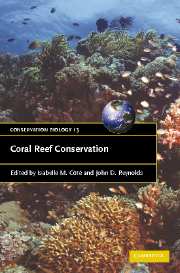Book contents
- Frontmatter
- Contents
- List of contributors
- Foreword
- Preface
- Part I Setting the stage
- Part II Uses and abuses: ecological and socio-economic issues
- Part III The way forward: tools and approache
- 9 New approaches to estimating recent ecological changes on coral reefs
- 10 Assessing the effectiveness of marine protected areas as a tool for improving coral reef management
- 11 Environmental impact assessment for coral reefs: advocating direct protective approaches
- 12 Time for a third-generation economics-based approach to coral management
- 13 Collaborative and community-based conservation of coral reefs, with reference to marine reserves in the Philippines
- 14 Education as a tool for coral reef conservation: lessons from marine protected areas
- 15 Adaptive institutions for coral reef conservation
- 16 Coral reef restoration with case studies from Florida
- 17 Redesigning coral reef conservation
- 18 Coral reef coda: what can we hope for?
- Index
- Plate section
- References
10 - Assessing the effectiveness of marine protected areas as a tool for improving coral reef management
Published online by Cambridge University Press: 05 June 2012
- Frontmatter
- Contents
- List of contributors
- Foreword
- Preface
- Part I Setting the stage
- Part II Uses and abuses: ecological and socio-economic issues
- Part III The way forward: tools and approache
- 9 New approaches to estimating recent ecological changes on coral reefs
- 10 Assessing the effectiveness of marine protected areas as a tool for improving coral reef management
- 11 Environmental impact assessment for coral reefs: advocating direct protective approaches
- 12 Time for a third-generation economics-based approach to coral management
- 13 Collaborative and community-based conservation of coral reefs, with reference to marine reserves in the Philippines
- 14 Education as a tool for coral reef conservation: lessons from marine protected areas
- 15 Adaptive institutions for coral reef conservation
- 16 Coral reef restoration with case studies from Florida
- 17 Redesigning coral reef conservation
- 18 Coral reef coda: what can we hope for?
- Index
- Plate section
- References
Summary
INTRODUCTION
Marine protected areas (MPAs) are considered an essential tool for protection of coral reefs (Roberts et al., this volume). Indeed, protected areas are now seen as a key mechanism for achieving the Convention on Biodiversity (CBD)'s overall goal of a significant reduction in the rate of biodiversity loss by 2010. A global target has therefore been set requiring ‘at least 10% of the world's ecological regions effectively conserved’, with representative protected area systems established by 2010. Recognizing that MPAs are lagging behind terrestrial protected areas, the deadline for the establishment of representative protected area systems in the marine environment has been extended to 2012.
While there has been a great deal of enthusiasm for the establishment of MPAs with coral reefs around the world, it has often proven easier to set them up than to manage them successfully. As emphasized in many chapters in this book, monitoring and assessment of conservation actions are essential and can lead to greatly improved management. Effectiveness of performance, and accountability, are increasingly demanded across all sectors of society and conservation is no exception (Margoluis and Salafsky, 1998). Indeed, the CBD recommends that appropriate methods, standards, criteria and indicators for evaluating the effectiveness of protected area management and governance should be developed and adopted by 2008, and 30% of protected areas ‘assessed’ in each country by 2010. Monitoring the effectiveness of protected areas has therefore acquired some urgency and many methods are being developed and tested at present.
- Type
- Chapter
- Information
- Coral Reef Conservation , pp. 314 - 331Publisher: Cambridge University PressPrint publication year: 2006
References
- 7
- Cited by



